When I’m talking to someone when they first come to see me, they always ask “Do I even qualify for benefits?” “How does this process go?” “How do we win and get awarded benefits?”
To answer these questions, I’m going to walk you through the process that the Social Security uses which is called the five step sequential process for awarding disability benefits. What sequential means is that you must pass each step as you go in order to move onto the next step.
A Brief Overview
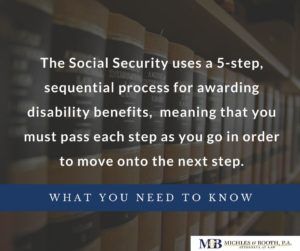 Steps one and two are really pre-qualification steps. Step one is: Are you working? Step two is: Do you have a serious medical condition?
Steps one and two are really pre-qualification steps. Step one is: Are you working? Step two is: Do you have a serious medical condition?
If you’re not working and if you have a serious medical condition, Social Security then goes onto steps three, or four and five. You could be found disabled at step three if you meet the adult listing of impairments, or steps four plus five if you cannot do any of your past work, which is step four, or if you cannot perform any other work in the regional or national economy, which is step five.
If you make it through steps one through five and the Social Security judge finds that you cannot do any of your past work or any other work or if you meet a specific listing of impairments you will be awarded benefits. Otherwise, your benefits will be denied.
The 5 Steps In Detail
To help assess your chances of successfully pursuing a Social Security Disability claim, let’s discuss the five steps in order.
Step 1
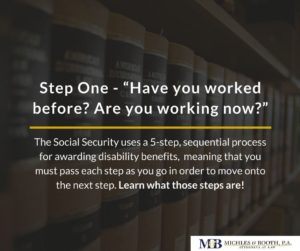 Step one is: “Have you worked before and are you working now?” What that means is Social Security requires you to have worked five out of the past 10 years on a regular basis in order to be eligible to even apply for Social Security Disability benefits. If it has been more than five years since you stopped working, you will not be entitled to Social Security Disability Insurance and will instead have to apply for Supplemental Security Income. The difference is a conversation for another day. Today we’re just discussing Social Security Disability Insurance.
Step one is: “Have you worked before and are you working now?” What that means is Social Security requires you to have worked five out of the past 10 years on a regular basis in order to be eligible to even apply for Social Security Disability benefits. If it has been more than five years since you stopped working, you will not be entitled to Social Security Disability Insurance and will instead have to apply for Supplemental Security Income. The difference is a conversation for another day. Today we’re just discussing Social Security Disability Insurance.
Once Social Security has confirmed that you have worked five of the past 10 years, they will then ask are you still working? You wouldn’t think it but working is actually a term of art in this instance.
What Social Security considers working is earning at or more than $1,170 per month. If you are earning at least that amount before taxes are taken out, Social Security will say that you are earning substantial gainful activity and are not disabled. This is regardless of whether or not you have a serious medical condition. Social Security will say that if you can earn that amount of money, the condition must not be that severe.
This frequently leads to what I call the Social Security catch-22, which is you have to stop working to apply for benefits, but how are you supposed to support yourself for two years while you await that decision? Unfortunately, there is no way around step one and it must be passed in order to move onto step two.
Step 2
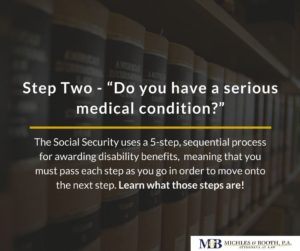 At step two, Social Security will ask: “Do you have a serious medical condition?” Social Security considers a medical condition serious if it has more than a minimal impact on your ability to perform basic work activities. This determination is made by medical evidence only and thus can only be proved by regular treatment with a medical professional. Because of this, routine medical treatment is absolutely essential to your Social Security Disability claim.
At step two, Social Security will ask: “Do you have a serious medical condition?” Social Security considers a medical condition serious if it has more than a minimal impact on your ability to perform basic work activities. This determination is made by medical evidence only and thus can only be proved by regular treatment with a medical professional. Because of this, routine medical treatment is absolutely essential to your Social Security Disability claim.
If you do not have insurance and are not treating on a regular basis, it will be absolutely necessary to get into one of the free clinics in your area or to borrow money from family and friends to treat with a medical professional.
Simply telling Social Security that you have a bad back or a serious mental health issue will not be enough to get you past step two of the sequential process. You will need the support of a medical professional, documented by medical evidence in his notes and diagnostics like MRIs in order to be successful at this step. If you have been successful at step one, that is you have worked five of the past 10 years and you’re going to the doctor, which confirms you have a serious medical condition, Social Security will then make a determination on whether or not that condition keeps you from working. This is done at step three or four plus five.
Step 3
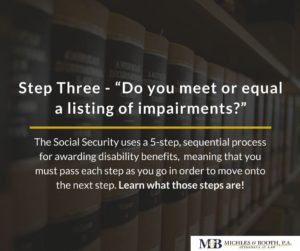 At step three, the Social Security Administration will ask do you meet or equal a listing of impairments? If you would like to see the listing of impairments you can just Google Social Security Administration listing of impairments. The listings are over a hundred very specific medical conditions that you can have and if you have one of those conditions you’re automatically accepted for disability.
At step three, the Social Security Administration will ask do you meet or equal a listing of impairments? If you would like to see the listing of impairments you can just Google Social Security Administration listing of impairments. The listings are over a hundred very specific medical conditions that you can have and if you have one of those conditions you’re automatically accepted for disability.
The problem is that it is very rare to meet a listing of impairments. The example I always give people is amputation. They believe that if they’ve lost an arm or a leg that Social Security will automatically accept them for disability. Unfortunately, that is not the case.
Social Security requires the amputation of both hands or both lower extremities with stump complications resulting in an inability to use a prosthetic device, or one hand and one lower extremity resulting in an inability to ambulate effectively, which means can you walk easily, or four, having your pelvis removed. As you can see, just losing an extremity, losing an arm or losing a leg by itself, is not going to get you disability. You need to lose more than one appendage unfortunately under step three. Fortunately, if you do not meet step three, we get to move onto step four and five still. This is where the vast majority of people are accepted for disability.
Before Step 4
Before starting step four, Social Security will ask what is your residual functional capacity to perform work activity? What that means simply is “what are your work restrictions?” It will be absolutely essential at this point of the sequential evaluation process to work with the doctor you’re treating with to have work restrictions assigned.
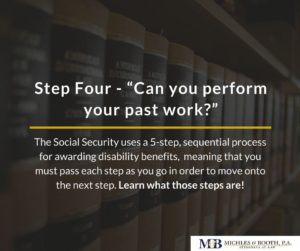 The Social Security Administration will need to know things like how much weight can you lift? How long can you stand? How long can you sit? Can you crouch, crawl, bend, stoop? Do you have problems interacting with people? Do you have problems interacting with supervisors? Do you have issues with attention and concentration either because of a health condition or because of medication side effects? These are all the things that contribute to your residual functional capacity to perform work activity. They are essential for your claim if we are to be successful at steps four and five.
The Social Security Administration will need to know things like how much weight can you lift? How long can you stand? How long can you sit? Can you crouch, crawl, bend, stoop? Do you have problems interacting with people? Do you have problems interacting with supervisors? Do you have issues with attention and concentration either because of a health condition or because of medication side effects? These are all the things that contribute to your residual functional capacity to perform work activity. They are essential for your claim if we are to be successful at steps four and five.
Step 4
Step four is can you perform your past work? Social Security will look at the jobs you’ve done over the last 15 years and make a determination, based on your residual functional capacity, as to whether or not you can do that past work.
For example, if you were in a tree trimming service and you lost a leg like we described at step three, you would not be able to do your past work because you could not climb ladders with only one leg. While you would not pass step three, you would move past step four in that example.
Step 5
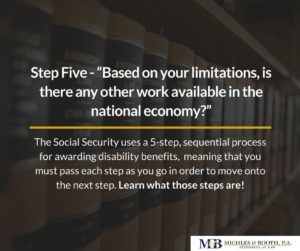 Social Security will then ask, well based on your limitations is there any other work available in the national economy? This is where most people lose their Social Security case because the question Social Security is asking is not whether there are jobs that are hiring or jobs that are available locally, it’s does a job exist in our country that you could still do with only one leg, in our example?
Social Security will then ask, well based on your limitations is there any other work available in the national economy? This is where most people lose their Social Security case because the question Social Security is asking is not whether there are jobs that are hiring or jobs that are available locally, it’s does a job exist in our country that you could still do with only one leg, in our example?
If the judge determines that you can’t do any of your past work and that your limitations because of your leg amputation prohibit any other work, then you will be found disabled. However, if the judge finds that there are still jobs you could do based on your age, education, and work history, the experience that you’ve gained, or your resume, then you will be found not disabled. As you can see, getting those work limitations from your doctor is absolutely essential to being successful at steps four and five of the sequential evaluation process.
If you have any other questions, please do not hesitate to contact me. I’m always available for a free initial consultation and would be happy to help you with your Social Security Disability claim. I wish you the best of luck.
View this article as a video: The 5-Step Process to Social Security Disability.
View the slidedeck for this video here: SSD – Do you qualify for benefits.
.jpg)
.jpg)